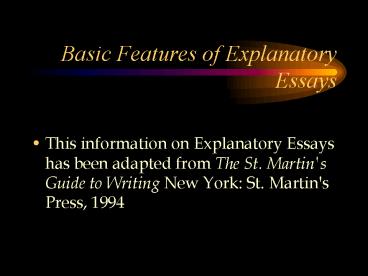Basic Features of Explanatory Essays PowerPoint PPT Presentation
1 / 21
Title: Basic Features of Explanatory Essays
1
Basic Features of Explanatory Essays
- This information on Explanatory Essays has been
adapted from The St. Martin's Guide to Writing
New York St. Martin's Press, 1994
2
Explanatory Essays display certain basic features
- a well-focused subject
- a narrow concept
- an appeal to readers interests
- a logical plan
- clear definitions
3
- writing strategies appropriate to the essays
point and to the kind of information it presents - careful use of sources
4
A well-focused subject
- The primary purpose for explaining a concept is
to inform readers - but writers of explanatory essays cannot possibly
hope to say everything there is to say about a
concept, nor would they want to - Instead they must make choices about what to
include, what to emphasize, and what to omit.
5
- Most writers focus on one aspect of the concept.
- Toufexis (you will read her essay shortly) for
example, focuses on the chemistry of love.
6
A main point or thesis
- In explaining a concept, you may make a point
about the concept. - You should not, however, argue any position or
case.
7
An appeal to readers interests
- In explaining concepts, good writers usually try
to appeal directly to their readers interests.
8
Appeal to Readers Interests
- They may put this appeal right at the beginning,
as Toufexis does by being - blunt "lets cut out all this nonsense about
romantic love" - and challenging "let's put love under a
microscope."
9
A logical plan
- Explanations must follow a clear path to keep
readers on track. - For organizing explanations and cueing readers,
experienced writers rely on many strategies.
10
A logical plan
- They divide the information in such a way that it
supports the main point and then alert readers to
these divisions with - forecasting statements,
- topic sentences,
- transitions,
- and summaries.
11
A logical plan
- In addition, they may try to frame the essay for
readers by relating the ending to the beginning.
12
A logical plan
- For example, Toufexis frames her essay with
references to Ph.D.s - she forecasts the three sciences from which she
has gleaned her information about the
neurochemistry of love - and nearly all of her paragraphs begin with a
transition sentence.
13
Good writers never forget that readers need clear
signals.
14
Clear signals
- Because the writer already knows the information
and is aware of how it is organized, it can be
difficult to see the way someone reading the
essay for the first time would. - That is precisely how it must be seen, however,
to be sure that the essay includes all the
signals the reader will need.
15
Essays explaining concepts depend on clear
definitions
16
Clear Signals
- In order to relate information clearly, a writer
must be sensitive to the readers' knowledge - any terms that are likely to be unfamiliar or
misunderstood must be explicitly defined
17
Essays explaining concepts depend on careful use
of sources
18
Careful use of sources
- Explaining concepts nearly always draws on
information from many different sources. - Writers often draw on their own experience and
observation. - But they almost always do additional research
into what others have said about their subject.
19
Careful use of sources
- Referring to sources, particularly to expert
ones, always lends authority to an explanation. - Students and scholars are expected to cite their
sources formally because readers judge their
writing in part by what theyve read and how
theyve used their reading.
20
Careful use of sources
- In English and humanities courses, we use Modern
Language Association (MLA) style. - This calls for parenthetical citations within the
essay that are keyed to a list of works cited at
the end.
21
Careful use of sources
- Make judicious decisions about when to
paraphrase, summarize, or quote your sources. - Whether you paraphrase, summarize, or quote your
sources, you must always give a parenthetical
citation to your source to avoid plagiarism.

